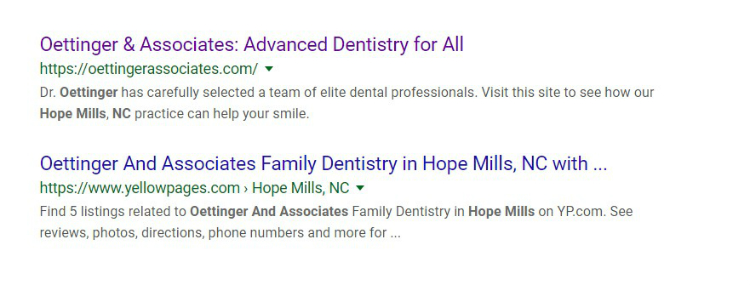Over one-third of small businesses currently employ an SEO strategy, and nearly two-thirds invest in social media marketing.
If you’re an entrepreneur in any industry, it’s becoming more important each year that you use SEO and social media to your benefit. These tools can provide enormous advantages when it comes to engaging with clients, finding new ones, and enhancing your brand recognition. Conversely, ignoring these powerful digital marketing tools can prevent your business from getting the attention it deserves.

While SEO and social media may seem complex, there are simple tips that even the least tech-savvy entrepreneurs can follow themselves. Explore these suggestions from an SEO specialist and a social media manager that are applicable to any type of business.
Three SEO Tips that Any Business Owner Can Use
Very few people search past the first page of their Google results. You truly may be the best in your industry, but if you neglect SEO, then your clients will be clicking on your competitors long before they even find you online. By following these three simple SEO tips, you can give your business a fighting chance to rank well and get the conversions it needs to thrive.

1. Start a Blog that Has Purpose
When many people start a blog, they typically make two mistakes:
- Too random with no clear theme or purpose
- Too limited and dry which bores readers
Blogging with Purpose
By deciding beforehand on a blogging strategy, you can create a blog that actually accomplishes something for your business. Choosing a purpose for your blogs adds a sense of focus and consistency that your readers will come to depend on. This purpose can be any number of things that make some part of your business easier, including:
- Blog to engage with your current clients and keep them interested in your company.
- Write blogs that move customers down your sales funnel by highlighting your benefits.
- Use blogs to give a voice to your company and make it sound more human.
- Create in-depth blogs that can establish you as an industry expert.
Whichever strategy you choose is up to you, but the important part is to consider which of the goals of blogging are most beneficial to your company. Once you have that goal in mind, then you can begin writing the best weekly blogs possible that comply with your strategy. Before long, you’ll see the fruits of your blogging, whether they come in the form of more conversions, greater brand recognition, or the respect of being an expert in your industry.
2. Get Familiar with Your Google Business Listing
If you’re unfamiliar with your Google Business Listing, it’s the information that comes up on the right side of the search results when you search for your business. There are thousands of potential listings a business can have online, and your Google Listing is by far the most important.

Essentially, the Google listing can be seen as the front entrance to your website, and when it’s lackluster and incomplete, it can quickly cause people to leave and search for competitors. By simply learning how to access your Google Listing and doing a few simple things to it, you can ensure that yours is working in your favor and not against it.
How to Access Your Google Business Listing
Start by logging in to the Google email account that’s associated with your business. You’ll see the icon for the account that’s currently active in the upper-right corner of your screen. Once the proper email account is active, simply type in “business.google.com” and it will take you to the listings you control. Select one of them to go to the dashboard and begin making updates.
Three Ways to Get the Most Out of Your Google Listing
After you know how to sign in to your Google Business Listing, there are a few simple things you can do to set it up for success.
- Fill in every category with thorough business information.
- Write an attractive business description.
- Create Google Posts regularly to highlight promotions and updates.
These three things are very simple and can make a huge difference. Any entrepreneur can take advantage of them to make their Google Listing shine, improving the first impression you make on potential clients.
3. Fill Out the Meta Descriptions and SEO Tags On Your Site
Business owners are often so engrossed in running and growing their business, that they find little time to explore the backend of their website. If the term backend causes confusion, it simply refers to the inner workings of the website where you can make changes to the pages, images, and content.
While mastering everything in the backend of your website would take a lot of time, ensuring your SEO tags and meta descriptions are optimized can provide a legitimate boost to your SEO. After logging into your website and selecting a page, you’ll find the SEO title tag and meta description towards the bottom below the main content of the site.

The Difference Between Optimized and Not Optimized
For those who are wondering why it matters if your meta description and SEO tag are optimized, check out the example below involving Oettinger & Associates.
The top listing is the one we wrote for their official site. As you can see, the SEO Tag which is the line on top with the larger text, states their business name followed by a brief description: “Advanced Dentistry for All”. The meta description below states the name of the owner, what the business does, their location, and ends by inviting the reader to take a look at their website.
The bottom listing is from YellowPages, and the SEO tag and meta description aren’t optimized. You can tell by the unfinished SEO tag and meta description — since the line ends before the text does, you don’t get the full message and it appears sloppy and incomplete. This isn’t an impression you want potential clients to have of your business, so it’s worth taking a few minutes to optimize each page of your website.

Facts to Know About Your Meta Descriptions and SEO Tags
Follow these tips to optimize your meta descriptions and SEO tags:
- Meta descriptions should be less than 160 characters.
- SEO tags should be between 50-60 characters so they’re fully displayed. Consider using a plug-in like Yoast to assist with optimizing these.
- Note that Google occasionally changes the character limit.
- Include a primary keyword in your SEO Title Tag – it’ll show up when searched
- Be as descriptive as possible about what’s on the page.
- Consider the combination of your SEO tag and Meta – don’t repeat information in both.
- It’s typically smart to include your business name and location.
Three Simple Ways Your Business Can Use Social Media
Social media plays a significant role in our lives and most people have made it a part of their routine to go on at least one social platform per day. As a business owner in today’s world, social media is where you should be branding yourself in order to attract consumers and sell your products, otherwise, your potential buyers will be choosing your competitors instead.

Whether you have yet to start a business page on Facebook, Instagram or LinkedIn, or you need help building your brand on these platforms, these three tips can help grow your business on social media.
1. Set Goals for Your Social Media Strategy
In order to get your business noticed on social media, you’ll first need to make a strategy. Set up your goals and determine what message you want to deliver. Your goals should be similar to your overall marketing objectives. Smaller, more attainable goals will benefit your long-term success and will be the key to your social media strategy.
Choose the Most Useful Platforms for You
Not every business will be successful on every social media platform. With hundreds of social media sites available today, and continuously growing, certain platforms may be better for you and your business than others.
To determine which kind of social media account you should create for your business, you should:
- Think about the customers you’re trying to reach.
- Research to see where your audience is.
- Look at competitor’s social media platforms.
- Understand which site will sell your product or service the best.
Schedule Your Posts in Advance

Planning ahead and being organized will always offer you and your business many benefits. When it comes to building your brand on social media, you want to plan ahead and show who you are and what your business is about right away.
If you’re starting fresh with a social account, you should plan to post a couple of photos or videos to kickstart the appearance of your brand’s presence. After you’ve created a good foundation for your account, you can create a content calendar and begin to schedule upcoming posts. This will help you stay consistent with your posts and eliminate the risk of rushing to share last-minute, low-quality content.
2. Get to Know Your Audience
After you’ve set your goals and created a strategy, the next step is to get to know your audience. Learn about the people you want to buy your product or service, research to see what kind of content they like to see, and find out what will make them want to choose you.

Understanding your audience inside and out will help your business strive on social media and, in turn, get you more customers. Nearly 71% of consumers who have had a good social media service experience with a brand are likely to recommend it to others. Word of mouth from your current customers will help your business be seen across all social platforms and allow it to grow.
Listen, Adapt, & Deliver the Right Content
Trying to figure out your audience and finding out what content they want to see can seem daunting at first. It may take some time to understand their wants and needs, but once you know, your social media strategy will skyrocket.
Now, how exactly do you get to know your consumers and identify their desires?
- Look over the demographics of your audience.
- Survey customers and listen to what they have to say.
- Connect with them and message them when necessary.
- Research your target audience’s online behavior.
- Adapt to what you find and implement it.
Once you learn more about your target audience and discover what they want to see, create unique, captivating, high-quality content, and share it across all your social media platforms.
3. Build a Relationship

A crucial aspect of growing your business on social media is building a trustworthy relationship with your audience. Consumers like to see that a business is personable and not just a nagging salesperson trying to get you to buy something. Connecting with people individually and getting to know your audience will help your clients appreciate and feel comfortable with your business more.
Engage with Your Followers
Publically talking and interacting with your audience helps attract new customers because it boosts brand awareness and shows you care about them. Showing potential new clients that you’re a personable business that isn’t afraid to be themselves on social media will help you truly connect with your audience and build a strong relationship, rather than being just a sale.
Ways you can engage with your audience on social media:
- “Like” your consumer’s comments and messages.
- Respond back to people and answer their questions.
- Interact with customer’s good reviews and recommendations
- Share photos of people using your product/service
This Facebook post below by Triad Cosmetic Dentistry shows that their team is staying active online, asking their audience to engage in the comments, and responding back individually to their followers while addressing each person by name. This post is fun and humanized, which shows their customers that they’re not just trying to get them through their office doors for money, but that they want to build a relationship with them.

Don’t Try to Oversell
The one thing people don’t enjoy seeing on their social media platforms is an overabundance of advertisements. Many times, these promoted ads on Facebook, Instagram, Pinterest, Twitter, or any other social channels are seen too often by people, and this may instigate a negative feeling about your brand.
A general rule of thumb for social media advertising is the 80/20 Rule– 80% of the content you share should be entertaining, yet informative, whereas the other 20% should directly sell and promote your business, products, and services.
If you oversell your products or services, your consumers will likely see your page as spammy and sometimes will even unfollow your business, which ultimately leads to lost revenue. Instead, you should incorporate articles, blogs, memes, photos, videos, and events happening near you to balance your social media page.
Do You Need Help with Your Business’s SEO & Social Media?
If your business is lacking SEO, a social media presence, or both, now’s the time to implement it in your marketing strategy. These two tools are vital in today’s marketing world and without them, your competitors will likely outrank you and take many of your consumers from you.
Don’t hesitate to ask us any questions about how to improve your business’s SEO or social media strategy in the comments below.
About the Authors

Jenna Toppin is a San Diego native who is a social media manager and writer at Now Media Group. In her time away from writing and working, Jenna loves to enjoy the beautiful outdoors of Southern California where she enjoys hiking, going to the beach, or camping. She also has always had a strong passion for fitness, health, beauty, and fashion.


Nick Napier: After serving 7-years in the Navy and traveling to 22 countries, Nick settled in San Diego where he earned his MBA. He currently works as an SEO Specialist while hosting the Rogue Writers Podcast and writing a wide variety of content on a daily basis.


